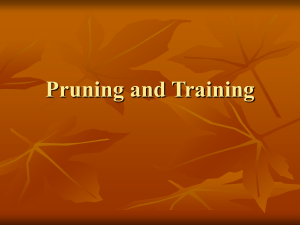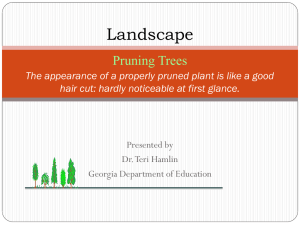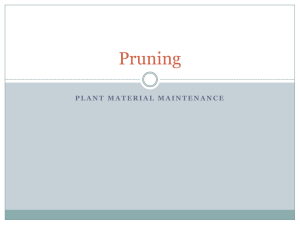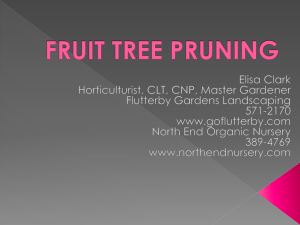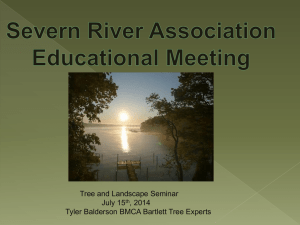Mature Trees
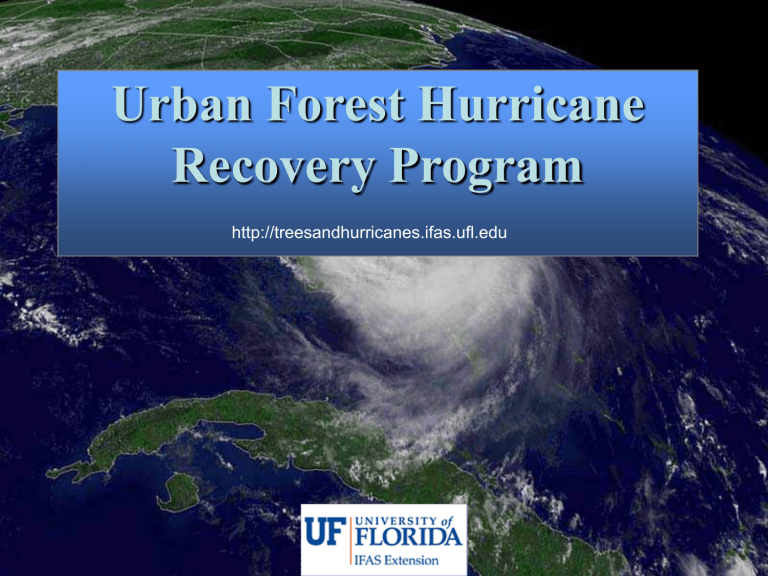
Urban Forest Hurricane
Recovery Program
http://treesandhurricanes.ifas.ufl.edu
Developing a preventive pruning program in your community:
Mature trees
Dr. Ed Gilman and Amanda Bisson
Inaction can cause structural problems
Young trees are easier to fix
Older trees are more challenging to treat
Codominant stems with bark inclusions
Poor structure such as codominant stems often cause branch failure in storms
Pruning can reduce damage
A recent study at UF showed that pruning reduces canopy movement when trees are exposed to high winds.
Not pruned
Reduction pruning
Your goal
Single trunk
Poor management
Multiple trunks
Better management
dead branch sucker codominant stems decay included bark dead branch water sprouts
Common mature tree problems broken branch
Preventive Pruning: mature trees
•
Set objectives
• Determine pruning cycle and dose
• Execute pruning plan
make good cuts
- prioritize trees with high risk structural issues
- choose appropriate pruning type
Pruning objectives:
• Reduce risk of failure – minimize storm damage
• Promote human safety
• Allow for safe passage
• Increase sun penetration to the ground
• Maintain health
Objective: Reduce risk of failure
• Identify risks
– Bark inclusions
– Cracks
– Over-extended limbs
– Leaning trees
– Root decay
– Girdling roots
• Reduce conditions that could lead to catastrophic branch or tree loss.
reduce
Strong union without a bark inclusion
Collar
Close-up of included bark
Failure due to bark inclusion
Cracks are evident and indicate weakness
Crack
Horizontal crack with crack
Broken branch
Reduction could have prevented this
Before pruning a leaning tree After pruning
Severed and decayed root systems
Stem girdling roots may cause trees to topple
Location of girdling roots. Notice that there are few supporting roots on this side of the tree.
Stem girdling roots
• Roots that circle around the base of the trunk
Girdling root
After removing girdling roots
Objective: Promote human safety
• Avoid expensive damage
Broken branch pruned away to free the car
Objective: Allow for safe passage
Notice the large limbs located close to the ground – these will eventually have to be removed for clearance.
Objective: Reduce shade
After thinning
More light here
Before thinning
Objective: Maintain tree health
Preventive Pruning: mature trees
• Set objectives
•
Determine pruning cycle and dose
• Execute pruning plan
make good cuts
- prioritize trees with high risk structural issues
-choose appropriate pruning type
Pruning cycle
• Pruning cycle is the time period between pruning episodes
• Pruning every 2 years results in trees better prepared for storms than longer cycles
• The sooner you begin pruning the less you will need to remove at each pruning
Pruning dose
• Old trees can decline as a result of removing too much live tissue.
• Try not to remove more than 10% of the live foliage on a mature tree.
• Remove more than 10% only for a good reason such as a cracked live branch over a house.
Remove live foliage only for a good reason!
Excessive sprouting as a result of stress caused from over pruning.
Risks of removing too much tissue
• Forces use of energy by initiating defense mechanisms.
• Removes energy reserves.
• Can cause cracks.
• Can cause sprouting.
• Can cause branch death.
• Can cause tree mortality.
• Reduces energy storage space.
Preventive Pruning: mature trees
• Set objectives
• Determine pruning cycle and dose
•
Execute pruning plan
make good cuts
- prioritize trees with high risk structural issues
- choose appropriate pruning type
Types of pruning cuts:
Reduction cut shortens the length of a stem by pruning back to a smaller limb.
Removal cut prunes a branch back to the trunk or parent branch.
Make good pruning cuts
Step 1
Make an undercut about 12 inches from the trunk.
Step 2
Make a top cut farther out on the limb.
Step 3
Remove the stub with final cut, being careful not to cut flush against the trunk.
Leave the collar intact.
Branch bark ridge
Collar
Collar: swollen area at the base of the branch where it joins the trunk.
The tissue is rich in energy reserves and chemicals that hinder the spread of decay. Good pruning cuts avoid cutting into the collar.
No collar visible imaginary line
Pruning cut
A
B
Angle ‘A’ should equal angle ‘B’
Bad cut- called a flush cut
Woundwood does not develop evenly
Reduction cut
1 Primary - do not remove
2 Secondary - almost never remove
3 Tertiary- carefully consider removal
4 Quaternary – could remove some
5 Quinary- could remove several
Types of preventive pruning: Mature
Trees
Structural pruning
Cleaning
Thinning
Raising
Reducing
Balancing
Root pruning
Palm pruning
Pruning to restore
Structural pruning shortens or thins certain stems and branches
Before After
Before
2
1
3
4 After
1 year later
2 years later
Preventive structural pruning
Before pruning
3 years later
After pruning
Three years later
Showing three cuts
Close-up of sweetgum
First cut
3.5 inch stem removed
Second cut
First cut
After pruning Before pruning
Pruning to: Clean
• Removal of dead, broken, rubbing, or diseased branches, and foreign objects.
• Reduces the risk of branches falling from the tree
Cleaning takes care of these
Broken branches
Pruning to: Thin
• The selective removal of small live branches to reduce crown density .
• Increases light and air penetration.
• Reduces the risk of storm damage.
How to thin a canopy
Dense canopy
Thinning removes entire branches back well into the canopy
Inappropriate thinning
Lions-tailing: trees with foliage concentrated at the tips of branches because inner branches were removed.
• More susceptible to hurricane damage
• Difficult to restore
HELP!
Two years later
Pruning to: Reduce
• The selective removal of branches and stems to decrease the height and/or spread of a tree
Reduction
• May be necessary to direct growth
• A better option is to plant a smaller tree
Think right tree right place!
Proper canopy reduction
Reduction cut
Excessive sprouting
Reduction Pruning
Proper vs. Improper (Topping)
Proper reduction Improper reduction
• reduces size while maintaining form
• minimizes re-growth
• cuts barely noticeable
• branch tips visible in outer canopy
• drastic form change
• sprouting
• cuts very noticeable
• branch tips not visible in outer canopy
• compromises structure
• promotes defects and decay
Sprouts
Topping trees promotes bad structure!
Not all tree species can be reduced
• Consider species and plant health before reducing the canopy
• More decay can enter the tree following reduction than following removal cuts
Pruning to: Raise
• The selective removal of branches to provide vertical clearance
• Best done over a period of years, not all at once
Large pruning cuts
Over-lifting causes stress resulting in sprouting
After lifting the canopy
Sprouts
Large lower branch removed
Two years later
Big cuts can result in decay and cracks.
Sprouts develop from large pruning cuts
Clearance can be achieved by shortening low branches rather than removing them.
Raising: a stepwise process
• Thin/reduce/remove the largest branches in the lower part of the tree.
• Leave smaller branches intact for one year.
• If necessary remove branches back to trunk one to several years later.
• Do not forget to correct any structural pruning needs.
Don’t forget structural pruning!
Pruning to: Balance
• Removes live branches to redistribute wind and gravity loads in the canopy.
Unbalanced canopy
Reduce this side of the canopy
Balance the right side of the canopy by reducing the large limb
before
Large pruning cut
Excessive end weight after
Clumped trees can fall over without treatment
Yikes!!
One side of this clumped tree broke off at the base
No roots present here
Balance canopies of clumped trees to prevent them from falling over
Reduce branched indicated with dotted lines
Pruning to: Correct root problems
Airspades show you what’s underground and may help uncover girdling roots
Pruning to: Restore
Palm Pruning
• Retain all green fronds
Coconut palms
Hotel sign
Remember your goals and objectives…
Produce a structurally sound tree
• Reduce risk of failure
• Promote human safety
• Allow for safe passage
• Reduce shade and wind resistance
• Maintain tree health and vigor
With dedication to a management plan, your community can become a model for others


